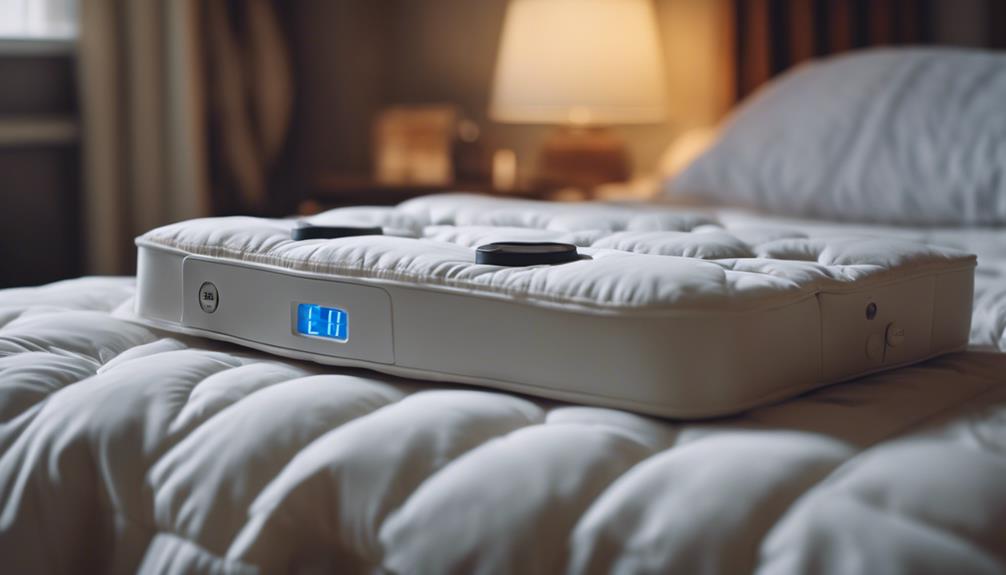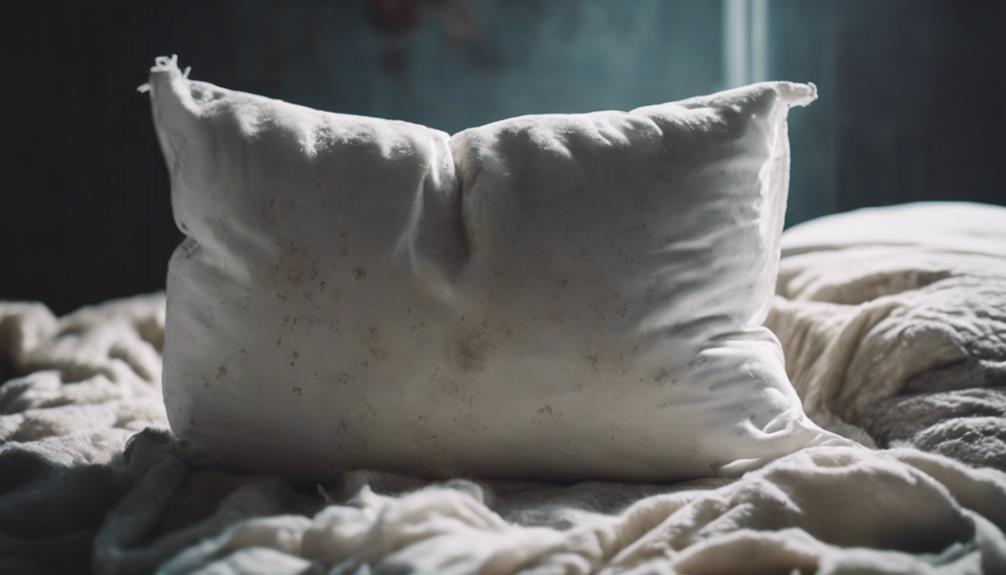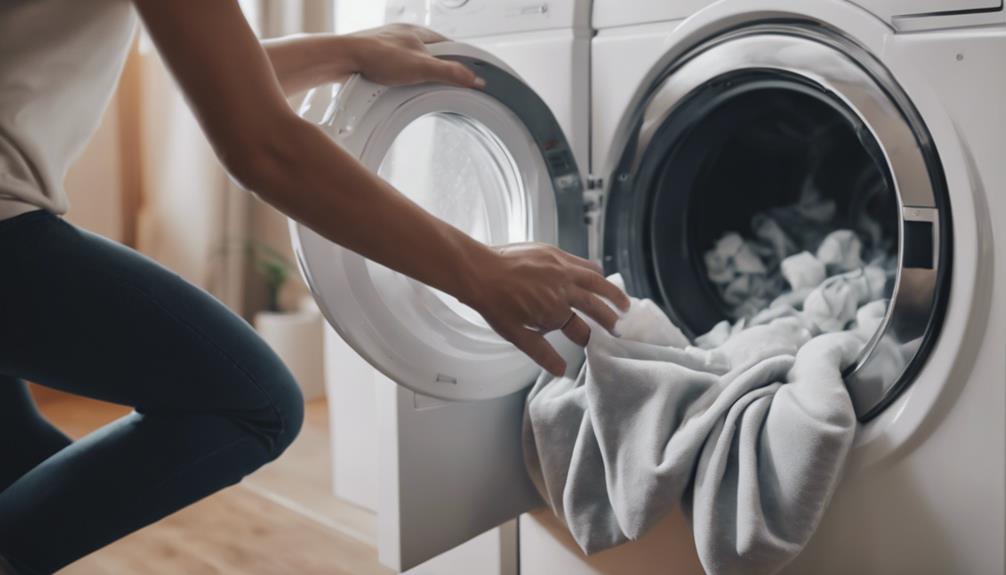Throw blankets typically have a lifespan of 5-10 years, but this can vary depending on the quality of the material, how well it is cared for, and how frequently it is used. High-quality materials tend to result in blankets that are more durable. Regular washing every two weeks, following care instructions, and storing the blanket in a cool, dry place can help to extend its lifespan. Signs such as odor, stains, or visible wear are indications that it may be time to replace the blanket. On the other hand, comforters can last up to 20 years with proper care. Understanding these factors is essential for maximizing the longevity of a throw blanket.
Key Takeaways
- Quality materials and care impact longevity.
- Regular washing and proper storage extend lifespan.
- Signs of wear indicate need for replacement.
- Throws last shorter than comforters with proper care.
- High-quality throws can last longer but need eventual replacement.
Factors Affecting Throw Blanket Longevity

When caring for throw blankets, the quality of materials, frequency of use, washing habits, and storage conditions all play vital roles in determining their longevity. To safeguard a throw blanket lasts, it's essential to provide proper care to maintain its quality. Regular washing, following the manufacturer's instructions, and storing it in a cool, dry place are key factors in extending its lifespan.
Signs of wear can serve as indicators that a throw blanket may need replacing. Thin fabric, pilling, or loss of softness are common signs of wear that suggest the blanket mightn't be as durable as before. By recognizing these signs early on, one can take steps to address them and potentially prolong the blanket's life.
Quality of Material and Durability
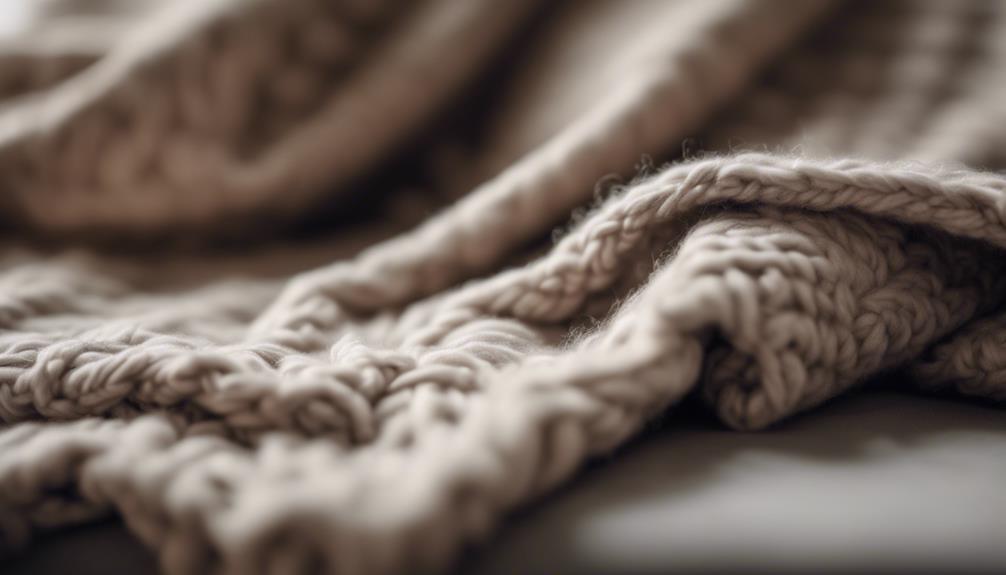
The durability of a throw blanket is directly influenced by the quality of the material it's made from. When considering the longevity of a throw blanket, it's essential to assess the material used in its construction. Higher quality materials often result in a more durable blanket that can withstand regular use over an extended period. Factors such as the type of fabric, the construction of the blanket, and how well it's maintained all play a vital role in determining its lifespan.
Quality materials can enhance the durability of the throw blanket.
Proper care, including washing and storage, can help maintain the blanket's quality.
Fabric type and construction are key factors in determining the longevity of the blanket.
Signs of wear like thinning fabric or fading colors indicate the need for a new throw blanket.
Proper Care and Maintenance Tips
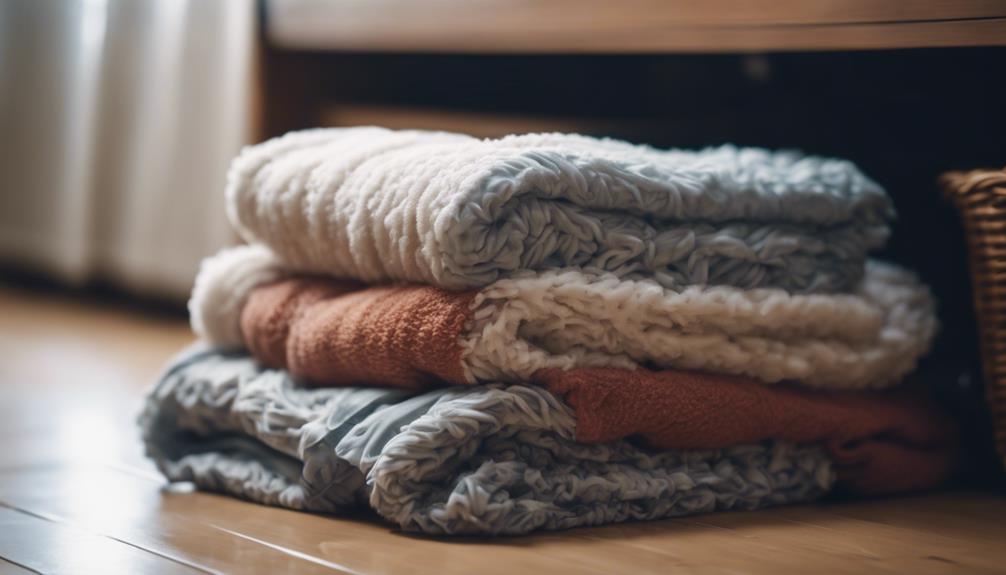
To maintain the longevity of a throw blanket, regular care and proper maintenance are essential. By following care instructions and adopting good practices, blankets can last for many years. Here are some tips for keeping your throw blanket in top condition:
| Care Tip | Description | Benefit |
|---|---|---|
| Follow care instructions | Check the label for specific washing and drying guidelines to prevent damage to the fabric. | Preserves the quality and durability. |
| Avoid excessive heat when drying | Use low or medium heat settings to prevent shrinkage and maintain the integrity of the material. | Extends the lifespan of the blanket. |
| Air dry or hang dry | Allow the blanket to dry naturally to retain its shape and texture, avoiding potential fabric distortion. | Helps preserve the overall appearance. |
| Store in a cool, dry place | Keep the blanket away from direct sunlight to prevent color fading and maintain its original quality. | Protects the fabric from damage over time. |
Frequency of Washing and Drying

We suggest washing your throw blanket every two weeks to maintain cleanliness and hygiene. Regular cleaning helps prevent dirt and odor buildup, ensuring your blanket stays fresh.
Factors like eating on the sofa or having pets on the blanket may require more frequent washing to keep it in top condition.
Washing Throw Blanket
Keeping throw blankets clean is essential for maintaining their quality and ensuring a hygienic environment. When it comes to washing throw blankets, experts recommend cleaning them every two weeks to uphold hygiene standards. However, for the average person, washing them at least once a month should suffice.
The frequency of washing may need to increase if you use the throw blankets while eating or around pets. Delicate materials like cable-knit should be washed in a large net laundry bag for protection. Hand-washing in cold water is suggested for fragile throw blanket materials to prevent damage.
Drying Throw Blanket
When considering the frequency of washing and drying throw blankets, it's essential to follow expert recommendations to maintain their cleanliness and freshness. Experts suggest cleaning throw blankets every two weeks to prevent dirt buildup and maintain a hygienic environment. However, the average person should aim to wash their throw blankets at least once a month to maintain a basic level of cleanliness.
Factors such as how frequently the throw blanket is used, whether it's exposed to food or pets, can impact the washing frequency. To prevent stains and germs from accumulating, it's advisable to stick to a regular washing schedule, ideally every other week.
Following specific washing and drying instructions can greatly extend the lifespan of your throw blanket.
Maintenance Tips for Blankets
To maintain the longevity of your throw blanket, it's important to follow a regular washing and drying schedule. Here are some key points to take into account when washing and drying your throw blankets:
- Experts recommend cleaning throw blankets every two weeks to maintain cleanliness and prevent stains.
- The average person should wash throw blankets at least once a month to guarantee hygiene.
- Factors like eating on the sofa or allowing pets on the throw may increase the need for more frequent washing.
- Regular use of throw blankets suggests washing every other week to prevent the buildup of germs and dirt.
Following these recommendations won't only keep your throw blanket fresh and clean but also help prolong its lifespan.
How to Store Throw Blankets Correctly
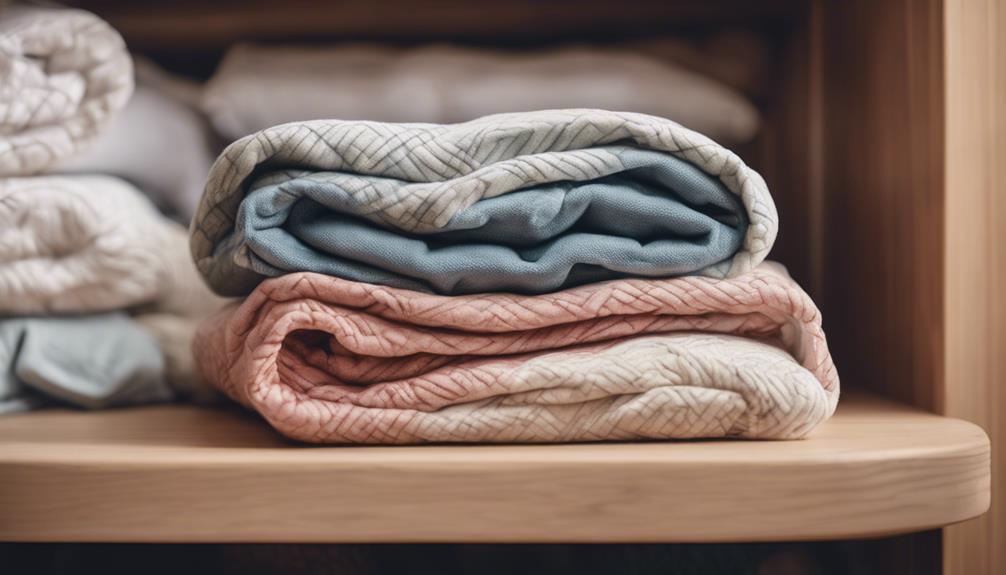
When storing throw blankets, it's important to place them in a cool, dry location to prevent mold growth.
Avoid direct sunlight exposure as it can lead to color fading over time.
Neatly folding the blankets helps prevent wrinkles and maintain their shape for a longer lifespan.
Proper Throw Blanket Storage
Proper storage of throw blankets in a cool, dry place is essential to maintain their quality and prevent damage from mold growth.
Neatly folding throw blankets can prevent wrinkles, keeping them looking tidy when not in use.
It's important to avoid storing throw blankets in direct sunlight to prevent color fading over time.
By following these storage practices, you can help prolong the lifespan of your throw blankets, guaranteeing they remain in good condition for longer periods.
Taking care to store your throw blankets correctly not only protects them from damage and deterioration but also ensures they continue keeping you warm effectively.
Ideal Storage Conditions
For essential preservation of throw blankets, store them in a cool, dry location to prevent mold growth and maintain their quality. It's important to avoid direct sunlight as it can cause color fading and damage to the fabric over time.
Neatly folding the throw blankets can help prevent wrinkles and maintain their shape for longer periods. Consider using storage bins or vacuum-sealed bags to shield the blankets from dust and pests, ensuring they stay in top condition.
Signs It's Time to Replace
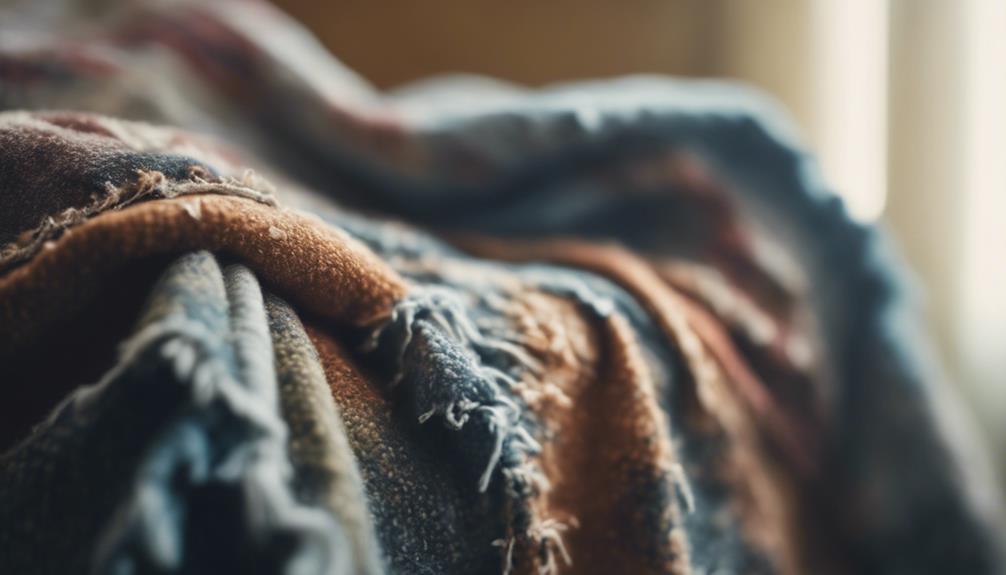
Noticing thinning fabric, tears, or loss of softness in your throw blanket are clear indications that it's time for a replacement. When considering whether to replace your throw blanket, keep in mind the following signs:
- Unremovable Odors: Persistent odors that don't disappear even after washing may signal it's time for a new throw blanket.
- Stains: Stubborn stains that resist all cleaning efforts can detract from the aesthetic appeal and functionality of the blanket.
- Excessive Wear and Tear: Fraying edges, unraveling threads, or pilling beyond repair are signs of significant wear that may warrant a replacement.
- Inadequate Warmth or Comfort: If your throw blanket no longer provides the cozy warmth or comfort it once did, it might be best to invest in a new one to enjoy those snug moments again.
Regularly inspecting your throw blanket for these signs can help you determine when it's time to part ways with the old and bring in the new.
Extending Lifespan With Careful Use
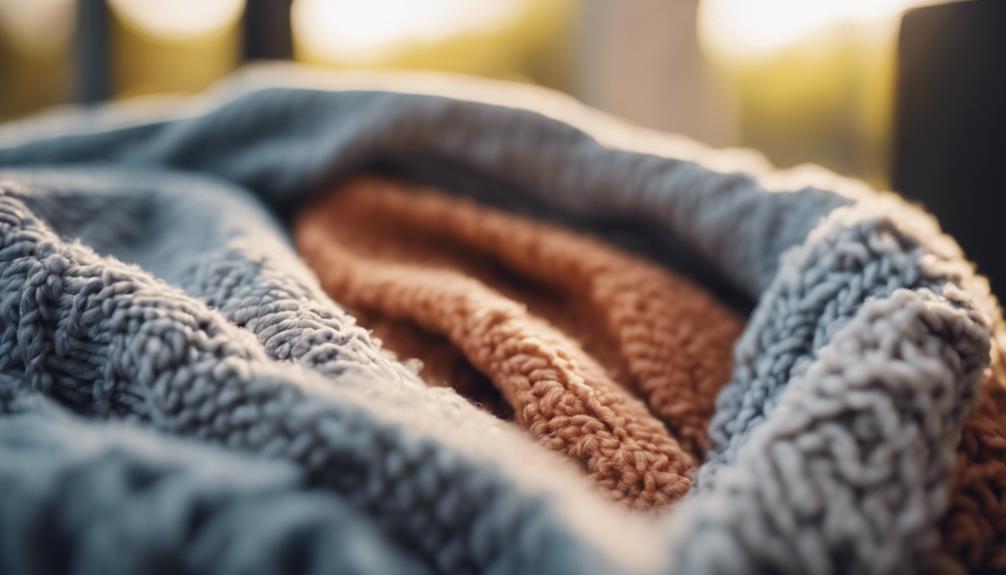
Inspecting a throw blanket regularly for signs of wear can help in extending its lifespan through careful use. By being mindful of how often you use and wash the throw blanket, you can prevent unnecessary damage and preserve its quality. Following the manufacturer's instructions for washing, using gentle detergents and avoiding harsh chemicals is crucial. Overwashing or using high heat can weaken the fibers, leading to premature wear and tear.
To guarantee the longevity of your throw blanket, consider rotating its use with other blankets to minimize constant friction and stress on the fabric. Additionally, inspect the blanket after each wash for any signs of thinning or tearing. When these signs become apparent, it might be time to replace the throw blanket to prevent further damage.
Comparison With Other Bedding Items
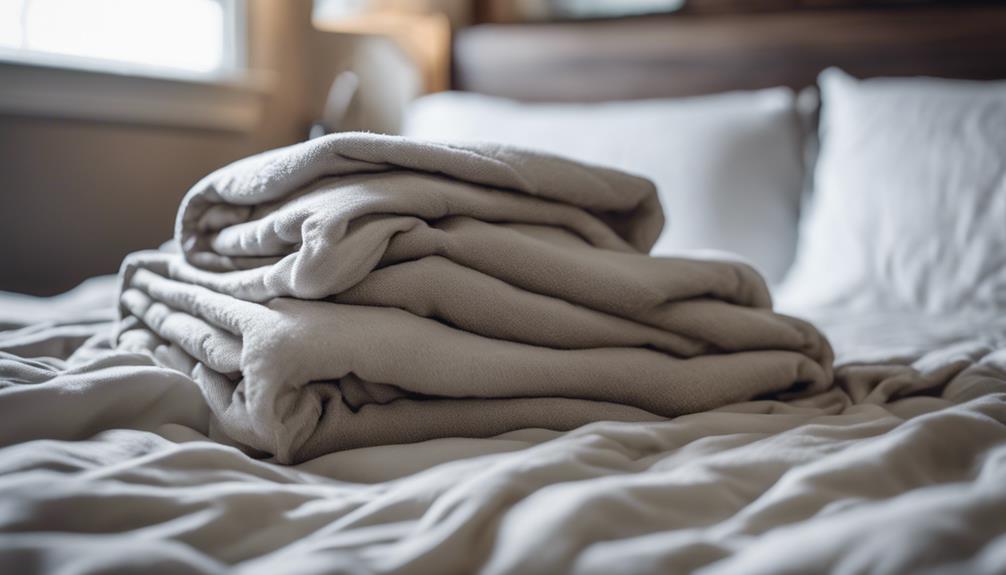
Regularly comparing throw blankets with other bedding items reveals their shorter lifespan compared to comforters, typically lasting 5-10 years depending on quality and material. While throws offer versatility and style, comforters outlast them regarding durability.
Here are some key points to keep in mind when contrasting throw blankets with other bedding items:
- Durability: Throws have a shorter lifespan compared to comforters, which can endure up to 20 years with proper care.
- Maintenance: Regular use and washing habits can have a substantial impact on the longevity of throws, necessitating more frequent replacements than comforters.
- Quality: Investing in a high-quality throw can extend its lifespan, but even the highest quality throws generally don't match the longevity of top-tier comforters.
- Signs of Wear: Keep an eye out for signs of wear on your throw blanket, such as thinning, pilling, fading colors, or loss of softness, which indicate the need for a replacement or upgrade.
Frequently Asked Questions
How Long Does the Average Blanket Last?
Throw blankets typically last between 5 to 10 years, depending on care. Factors like material quality, usage, and cleaning methods influence lifespan. High-quality blankets made from durable materials like wool or cashmere last longer.
Regular washing and proper storage can extend their longevity. Signs of replacement include thinning fabric, loss of softness, or significant wear. Proper maintenance is key to ensuring a blanket's lasting comfort and warmth.
Do Throw Blankets Need to Be Washed?
Throw blankets do need washing. To keep them clean, it's best to wash them every 2 weeks. This frequency helps prevent stains and germs from building up.
If you eat on the sofa or have pets around, you might need to wash them even more often. Experts suggest a minimum of once a month for washing to maintain cleanliness.
Adjust based on usage habits and desired cleanliness level for best blanket longevity.
How Often Should You Change Your Blanket?
When considering how often to change your blanket, factors like frequency of use and wear should guide your decision. Regularly inspecting your blanket for signs of wear, such as thinning fabric or tears, can help determine when it's time for a change.
High-quality blankets may last 5-10 years with proper care, but lower-quality ones may need replacing sooner. Stay vigilant in monitoring your blanket's condition to guarantee maximum comfort and longevity.
How Often Should You Wash a Bed Throw?
We recommend washing bed throws every two weeks to maintain freshness and cleanliness.
This frequency helps prevent the buildup of dirt, oils, and germs, especially if you use your throw regularly or have pets that enjoy snuggling up with you.
By washing your bed throw every other week, you can guarantee it stays in good condition for a longer period.
Regular washing also helps maintain the quality of the fabric and keeps it looking great.
Does Putting a Throw Blanket on the Bed Extend Its Lifespan?
Putting a throw blanket on the bed can not only add warmth and style but also protect the bedspread from wear and tear. The best placement for a throw blanket is folded at the foot of the bed, preventing it from getting tangled or causing discomfort during sleep.
Conclusion
To sum up, the longevity of a throw blanket depends on various factors such as material quality, care, and frequency of use. By following proper maintenance tips and recognizing signs of wear and tear, you can extend the lifespan of your throw blanket.
Remember, a well-cared-for throw blanket can last for many years, providing warmth and comfort. So, keep an eye on its condition and enjoy the cozy embrace of your favorite throw for as long as possible.

